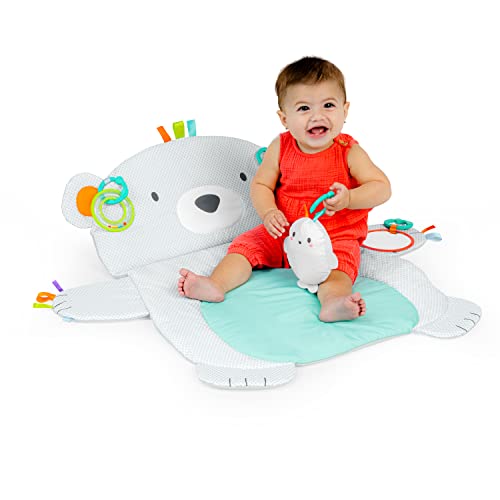Tummy Time: Essential for Baby Development
*We may earn a commission for purchases made using our links. Please see our disclosure to learn more.
Every parent faces that moment of uncertainty when they first place their precious newborn on their tummy for supervised play. The initial protests, the wobbling attempts to lift that seemingly heavy head, and the questions about whether this uncomfortable-looking position could really be beneficial—these experiences are universal among new parents. Yet within these challenging early moments lies one of the most transformative activities for infant development.
Tummy time represents far more than a simple exercise routine. It’s a daily investment in your baby’s future strength, coordination, and confidence. When babies spend time on their stomachs during supervised awake periods, they’re not just building muscle—they’re developing the neurological pathways that will support everything from crawling and walking to fine motor skills and cognitive processing. Understanding both the science behind tummy time and practical strategies for making it successful can transform this potentially frustrating activity into an enjoyable bonding experience that accelerates your baby’s development in remarkable ways.
“Tummy time is one of the most important activities you can do with your baby during their first year of life. It helps build the foundation for all future movement and development.”
– American Academy of Pediatrics
Key Takeaways
- Start early: Begin tummy time as soon as you bring your baby home from the hospital
- Build gradually: Start with 2-3 minutes several times per day and increase duration as your baby grows stronger
- Make it enjoyable: Use colorful toys, mirrors, and interactive play to keep your baby engaged
- Stay consistent: Aim for a total of 60 minutes of tummy time daily by 3 months of age
- Always supervise: Never leave your baby unattended during tummy time sessions
Recommended Tummy Time Products
1. Bright Starts Tummy Time Activity Mat
The Bright Starts Tummy Time Prop & Play Baby Activity Mat is designed to make tummy time comfortable and fun for newborns and growing babies. Featuring a soft polar bear design, this 35 x 29.5-inch mat includes a supportive prop pillow, taggies, and toy attachments to keep your baby entertained. The baby-safe mirror and rattle add sensory play while helping strengthen neck, shoulder, and arm muscles. Lightweight and easy to store, it’s perfect for both home use and travel.
A colorful play mat with removable toys, mirrors, and different textures to keep babies engaged during tummy time sessions. Features a supportive pillow for comfort.
- Comfort: Soft plush mat with support pillow makes tummy time cozy and safe.
- Engagement: Includes mirror, rattle, and taggies to stimulate sensory development.
- Portability: Compact size makes it easy to use in small spaces or while traveling.
- Size: May feel small as babies grow beyond the newborn stage.
- Cleaning: Spot cleaning is required, not machine washable.
- Variety: Limited toy attachments compared to larger activity gyms.
2. Skip Hop Explore & More Baby’s View 3-Stage Activity Center
The Skip Hop Baby Activity Center: Explore & More is an interactive play center designed to grow with your child through three stages—Sit, Swivel, Bounce & Play; Cruise & Interact; and finally a smooth play table for toddlers. Packed with over 25 developmental activities, it includes a musical light-up piano, peek-a-boo owl, and repositionable clip-on toys to match your baby’s abilities. The unique Discovery Window helps babies see their feet while playing, encouraging cause-and-effect learning. Built for convenience, it features a machine-washable polyester seat, dishwasher-safe snack bowl, and detachable legs for easy storage. Ideal for babies 4 months and up, it supports up to 25 lbs and offers lasting value as your little one grows.
An adjustable activity center that grows with your baby, featuring tummy time mode with engaging toys and sensory elements.
- Development: 25+ activities support sensory, motor, and cognitive growth.
- Longevity: 3-in-1 design grows with baby from 4 months to toddler stage.
- Convenience: Easy-to-clean seat and snack bowl, with quick tool-free setup.
- Price: Higher cost compared to basic activity centers.
- Space: Larger footprint, not ideal for small living areas.
- Weight Limit: Supports up to 25 lbs, may be outgrown sooner for bigger babies.
3. Infantino Prop-A-Pillar Tummy Time & Seated Support
The Infantino Prop-A-Pillar Tummy Time & Seated Support is a versatile baby floor seat designed to grow with your little one from the newborn stage onward. This plush caterpillar-shaped support pillow works as both a tummy time prop and an early sitting aid, helping strengthen neck, core, and motor skills. Soft C-shaped cushions cradle your baby from head to hips, while engaging toys—including a BPA-free teether and plush sun—encourage sensory exploration. Lightweight, foldable, and easy to clean, it’s perfect for everyday use at home or while traveling.
A versatile inflatable pillow that provides gentle support for tummy time while encouraging head lifting and strengthening core muscles.
- Versatility: Functions as both tummy time support and an early sitting aid.
- Engagement: Includes interactive toys to boost fine motor and sensory skills.
- Convenience: Portable, folds flat, and easy to wipe clean.
- Support: May not offer enough structure for babies with weaker head control.
- Cleaning: Wipeable only, not fully machine washable.
- Size: Best for smaller infants; may feel snug as baby grows.
4. Lamaze Freddie the Firefly Tummy Time Toy
The Lamaze Freddie the Firefly Clip-On Toy is a colorful and engaging sensory toy designed to entertain and comfort babies from birth. With crinkly wings, a baby-safe mirror, and textured teething star, it stimulates touch, sight, and sound while encouraging fine motor development. Perfect for on-the-go play, the large clip easily attaches to strollers, car seats, diaper bags, or play gyms, making it a versatile travel companion. Designed to spark bonding moments, Freddie the Firefly is a playful way to support your baby’s early learning and sensory exploration.
An interactive plush toy with crinkle sounds, textures, and a baby-safe mirror designed specifically to make tummy time more engaging and fun.
- Engagement: Bright colors, textures, and sounds keep babies entertained.
- Portability: Easy clip-on design attaches to strollers, car seats, or bags.
- Development: Supports sensory growth, fine motor skills, and visual tracking.
- Size: May feel bulky on smaller strollers or diaper bags.
- Cleaning: Surface clean only, not machine washable.
- Age Range: Best suited for young infants; older babies may outgrow interest.
Understanding the Foundation of Movement
Every parent wants their baby to reach developmental milestones with confidence and strength. Yet many underestimate the profound impact that those precious minutes spent on the tummy can have on their child’s entire developmental trajectory. Tummy time serves as the foundation upon which all future movement patterns are built—from rolling and crawling to eventually walking and running.
When babies spend time on their stomachs while awake and supervised, they engage muscles that rarely get activated when lying on their backs or sitting in carriers. The neck, shoulders, arms, and core muscles all work together in ways that prepare the body for complex movements to come. This isn’t just about physical strength; it’s about creating neural pathways that support coordination, balance, and spatial awareness.
The Science Behind the Benefits
Physical Development Milestones
The physical benefits of tummy time extend far beyond simple muscle strengthening. When babies lift their heads against gravity, they’re developing the cervical spine’s natural curve, which is essential for proper posture throughout life. The weight-bearing aspect of tummy time also promotes bone density and joint stability in the shoulders and hips.
Research consistently shows that babies who receive adequate tummy time demonstrate earlier achievement of motor milestones. They typically show better head control by 2-3 months, begin rolling between 4-6 months, and often crawl earlier than babies who don’t receive sufficient tummy time. These early achievements create a cascade effect, boosting confidence and encouraging further exploration.
Cognitive and Sensory Benefits
The benefits extend well beyond the physical realm. During tummy time, babies experience the world from a completely different perspective. This change in viewpoint stimulates visual development and depth perception in ways that back-lying simply cannot provide. The sensory input from feeling different textures against their chest and arms, combined with the vestibular stimulation from lifting and turning their head, creates rich neural connections that support cognitive development.
Many parents notice that babies become more alert and engaged during tummy time sessions. This heightened awareness isn’t coincidental—it’s the result of increased sensory input and the brain’s response to new challenges and perspectives.
Preventing Flat Head Syndrome
One of the most immediately visible benefits of regular tummy time is the prevention of positional plagiocephaly, commonly known as flat head syndrome. Since the “Back to Sleep” campaign began recommending that babies sleep on their backs to reduce SIDS risk, there has been an increase in flat spots developing on babies’ heads.
Tummy time provides essential relief from back-lying positions, allowing the skull to maintain its natural round shape. When combined with varying head positions during supervised awake time, tummy time significantly reduces the risk of developing asymmetrical head shapes that may require costly and time-consuming treatment later.
Overcoming Common Challenges
When Baby Resists Tummy Time
It’s completely normal for babies to initially protest tummy time. After spending months in the womb in a curled position, lying flat on the tummy can feel foreign and challenging. Many parents feel discouraged when their baby cries during these sessions, but resistance is often a sign that important developmental work is happening.
Start with very short sessions—even 30 seconds counts as progress for a newborn. Place your baby on your chest while you lie back at a 45-degree angle, creating a gentler introduction to the tummy-down position. The comfort of your heartbeat and familiar scent can make this new position more acceptable.
Creating Engaging Environments
Transform tummy time from a chore into an adventure by creating stimulating environments. Place colorful toys just within your baby’s line of sight, encouraging them to lift their head higher and reach forward. Baby-safe mirrors are particularly captivating, as infants are naturally drawn to faces, even their own reflection.
Consider the surface as well. While a firm, flat surface is safest, you can add interest with different textures. A soft blanket, a play mat with varied textures, or even your own body can provide the sensory variety that keeps babies engaged and curious.
Timing and Frequency Strategies
The timing of tummy time sessions can significantly impact your baby’s tolerance and enjoyment. Avoid scheduling sessions immediately after feeding, as the pressure on a full stomach can cause discomfort and spit-up. Instead, choose times when your baby is alert but not overly hungry or tired.
Many successful parents incorporate tummy time into diaper changes, placing baby on their tummy for a few minutes before putting on a fresh diaper. This routine helps establish consistency while taking advantage of natural opportunities throughout the day.
Age-Appropriate Progressions
Newborn Stage (0-2 months)
During the earliest weeks, tummy time sessions should be brief but frequent. Start with 2-3 minutes, 3-4 times per day. At this stage, simply tolerating the position is an achievement. You might notice your baby can only lift their head briefly or turn it from side to side.
Focus on comfort and gradual acclimation rather than duration. Skin-to-skin tummy time on your chest provides the perfect introduction, combining the benefits of the position with the security of close contact.
Developing Strength (2-4 months)
As neck and shoulder strength develops, you’ll notice your baby can hold their head up for longer periods and with greater steadiness. This is the time to gradually increase session length to 5-10 minutes and introduce more interactive elements.
Toys with high contrast patterns, gentle music, or your own animated voice can help maintain interest during these longer sessions. Many babies begin to enjoy tummy time more during this phase as they develop the strength to be comfortable in the position.
Active Exploration (4-6 months)
By this stage, many babies can lift not just their head but their chest, supporting themselves on their forearms. Some begin reaching for toys while maintaining their position, demonstrating the coordination that tummy time has been building.
Sessions can now extend to 15-20 minutes, and babies often show clear preferences for certain toys or activities during tummy time. This is an excellent period to introduce cause-and-effect toys that respond to batting or reaching.
Pre-Crawling Preparation (6+ months)
Older babies who have mastered basic tummy time may begin showing pre-crawling behaviors like rocking on hands and knees or pivoting in circles while on their bellies. Continue tummy time even as these skills emerge, as the position continues to strengthen the core muscles essential for crawling and eventual walking.

Incorporating Tummy Time Into Daily Routines
Morning Energizers
Many parents find that morning tummy time sessions work well when babies are naturally alert and rested. After a diaper change and before the first feeding of the day, babies often have the energy and interest needed for quality tummy time.
Use this time for interactive play, singing songs, or simply talking to your baby. The natural light from windows can provide appealing visual stimulation, and the fresh start to the day often means better tolerance for this important activity.
Afternoon Adventures
Midday sessions can be incorporated into play time, either on the floor with toys or during outdoor time on a blanket. The change of environment and different lighting conditions provide new sensory experiences that enhance the benefits of the position itself.
Consider making afternoon tummy time a social activity, inviting siblings to lie down nearby or engaging in peek-a-boo games that encourage head lifting and visual tracking.
Evening Wind-Down
While tummy time is generally an active, stimulating activity, gentler evening sessions can work well for some babies. Focus on quiet interaction, soft singing, or gentle massage during these sessions. The goal is maintaining the physical benefits while supporting the transition toward bedtime routines.
Supporting Your Baby’s Individual Journey
Recognizing Personal Preferences
Every baby develops at their own pace and shows individual preferences for activities, positions, and stimulation levels. Some babies naturally take to tummy time, while others require more creative approaches and patience. Neither response indicates anything about your baby’s future development or abilities.
Pay attention to your baby’s cues about what works best for them. Some prefer music during tummy time, while others are more responsive to visual stimulation. Some do better with shorter, more frequent sessions, while others build up to longer periods of play.
Adapting for Different Temperaments
Sensitive babies might need extra gradual introduction to tummy time, with more comfort measures and shorter initial sessions. Highly active babies might actually crave the physical challenge and stimulation that tummy time provides, making it easier to establish regular routines.
Reflective babies often enjoy the quiet observation opportunities that tummy time provides, particularly when positioned where they can watch household activities or observe interesting visual displays.
When to Seek Guidance
While most babies will eventually accept and benefit from tummy time with consistency and patience, some situations warrant professional consultation. If your baby consistently shows extreme distress that doesn’t improve over several weeks of gentle attempts, or if you notice significant asymmetries in head shape or movement patterns, discussing these observations with your pediatrician can provide valuable guidance.
Physical therapists specializing in pediatric development can offer specific strategies for babies who need additional support in building tolerance or strength for tummy time activities.
Long-Term Impact on Development
Building Confidence Through Challenge
The process of mastering tummy time teaches babies that they can overcome challenges through persistence and practice. This early lesson in resilience and capability extends far beyond physical development, laying groundwork for approaching new challenges throughout childhood and beyond.
Babies who experience success during tummy time often show increased willingness to attempt new physical challenges as they grow. The confidence built through mastering head control and eventually pushing up to see their surroundings translates into curiosity and enthusiasm for exploration.
Establishing Healthy Movement Patterns
The movement patterns established during tummy time create templates for more complex activities throughout childhood. The core strength, coordination, and spatial awareness developed during these early sessions support not just crawling and walking, but eventually running, climbing, and participating in sports and recreational activities.
Research suggests that children who received adequate tummy time as infants often show better posture, core strength, and overall physical confidence during their school years.
Supporting Academic Readiness
The cognitive benefits of tummy time extend into academic preparation as well. The visual-motor integration skills developed while reaching for toys during tummy time support later writing and reading abilities. The spatial awareness and bilateral coordination strengthened during these sessions contribute to mathematical understanding and problem-solving skills.
The focus and persistence required to tolerate and eventually enjoy tummy time also build attention skills that serve children well in classroom settings.
Creating a Supportive Community
Sharing the Journey
Tummy time can become a wonderful opportunity for family bonding and creating shared experiences. Siblings often enjoy participating by lying nearby, showing toys, or simply providing encouraging chatter during sessions.
Consider documenting your baby’s tummy time progress through photos or videos. Many parents find it encouraging to look back at early sessions when their baby could barely lift their head and compare them to later achievements of rolling or preparing to crawl.
Connecting with Other Parents
Sharing tummy time experiences with other parents can provide both practical tips and emotional support. Many parents find creative solutions to common challenges through casual conversations with others going through similar experiences.
Online communities and local parent groups often share resources for making tummy time more enjoyable and effective. These connections can also provide reassurance during phases when progress seems slow or when babies go through temporary resistance to the activity.
Looking Forward: The Foundation You’re Building
As you establish tummy time routines and watch your baby gradually strengthen and develop new skills, remember that you’re providing far more than just physical exercise. Every minute spent encouraging your baby to experience the world from this challenging but important position contributes to their overall development and future capabilities.
The patience you show during difficult sessions, the creativity you bring to making the experience enjoyable, and the consistency you maintain even when progress seems slow all communicate important messages to your growing child about perseverance, support, and the value of working toward goals.
The strong foundation you’re building through regular tummy time will support your child through countless future adventures—from their first attempts at crawling to their confident first steps, and eventually to all the running, jumping, climbing, and exploring that childhood has to offer.
Your commitment to this simple yet profound activity represents an investment in your child’s lifelong health, confidence, and capabilities. Every session matters, every small improvement is worth celebrating, and the foundation you’re building together will serve your child well throughout their entire journey of growth and development.
Through tummy time, you’re not just strengthening muscles—you’re nurturing resilience, building confidence, and supporting the incredible process of human development that transforms your tiny baby into a capable, curious, and confident individual ready to explore and engage with the world around them.
Frequently Asked Questions
1. How early can I start tummy time with my newborn?
You can begin tummy time as early as the first day home from the hospital. Start with brief 1-2 minute sessions on your chest while you’re reclined, making it comfortable for both you and your baby. The key is starting gently and building gradually as your baby develops strength and tolerance.
2. What should I do if my baby cries every time during tummy time?
Crying during tummy time is completely normal, especially in the beginning. Try shorter sessions (even 30 seconds counts), different positions like on your chest, or distracting with toys and songs. If crying persists after several weeks of consistent attempts, consult your pediatrician to rule out any underlying issues.
3. How much tummy time should my baby get each day?
Aim for a total of 60 minutes spread throughout the day by 3 months of age. Start with 2-3 minutes several times daily for newborns, gradually increasing duration and frequency. Remember that several short sessions are often more effective and tolerable than one long session.
4. Is it safe to do tummy time on a bed or couch?
Always do tummy time on a firm, flat surface on the floor for safety. Beds and couches are too soft and pose suffocation risks. Use a clean blanket or tummy time mat on the floor to provide a safe, appropriate surface for your baby to practice this important skill.
5. When should I be concerned about my baby’s tummy time progress?
Contact your pediatrician if your baby cannot lift their head at all by 3-4 months, shows significant resistance after 6-8 weeks of consistent practice, or if you notice asymmetrical movements or head positioning. Most babies show steady progress with patience and consistency, but professional guidance can help address any concerns.
















